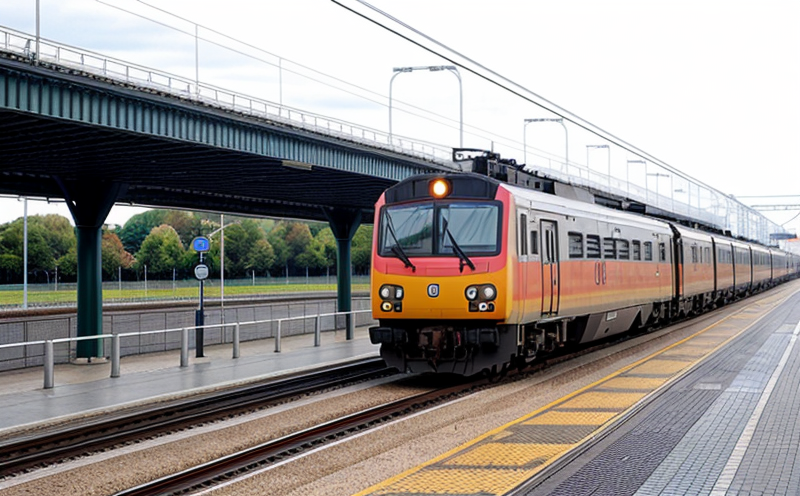ISO 1996-2 Environmental Noise Impact from Railways Testing
The ISO 1996-2 standard provides a method to measure and predict the environmental noise impact of railway systems. This service is crucial for ensuring that railways comply with international standards, maintain public health, and contribute positively to their surroundings.
The ISO 1996-2 protocol is widely recognized by regulatory bodies around the world as it offers a standardized approach to quantifying noise emissions from trains. By adhering to this method, railway operators can demonstrate compliance with environmental regulations while also enhancing their reputation for responsible operation.
This service involves several stages: initial site assessment, data collection using appropriate instrumentation, analysis of collected data, and finally, reporting the results in accordance with ISO 1996-2. Our team will ensure that every step adheres strictly to international standards, providing accurate and reliable noise impact assessments.
The significance of this testing cannot be overstated. Noise pollution from railways can have detrimental effects on human health and local ecosystems. By conducting these tests, we contribute to reducing environmental impacts, improving community well-being, and supporting sustainable transportation solutions.
To achieve the best results, proper preparation is essential. This includes selecting suitable measurement points along the railway route, ensuring that all equipment is calibrated correctly, and following strict protocols for data collection. Our experienced professionals will guide you through each phase of the process to ensure accuracy.
The methodology outlined in ISO 1996-2 includes various parameters such as sound pressure levels (SPL), frequency bands, and distance from the source. These factors are critical in determining the overall noise impact. Our technicians use advanced instruments like sound level meters and octave band analyzers to capture precise measurements.
After collecting the necessary data, our experts apply statistical techniques to interpret the results accurately. This step is vital for ensuring that the findings align with ISO 1996-2 requirements. Once processed, we prepare a comprehensive report detailing our observations and recommendations based on the analysis.
The final output of this testing provides valuable insights into how railways affect their environment. These reports are instrumental in guiding decision-making processes regarding infrastructure development and operational adjustments aimed at minimizing noise pollution. They also serve as essential documentation for regulatory compliance purposes.
By leveraging ISO 1996-2, we not only meet current standards but also contribute towards future improvements by identifying areas where enhancements could be made. This proactive approach helps maintain a balance between efficient transportation and sustainable development goals.
Scope and Methodology
The scope of ISO 1996-2 environmental noise impact testing from railways encompasses several key aspects:
- Measurement points along the railway route, including residential areas, schools, hospitals, etc.
- Data collection using sound level meters and octave band analyzers.
- Analysis of collected data to determine sound pressure levels (SPL) across different frequency bands.
- Reporting results in accordance with ISO 1996-2 guidelines.
The methodology involves meticulous planning, execution, and interpretation. Each stage requires adherence to strict protocols to ensure accuracy and reliability of the findings. Our team utilizes state-of-the-art equipment calibrated according to international standards.
For effective measurement, it’s important to select appropriate locations where noise levels are likely highest. This could include near railway stations, busy tracks, or areas densely populated by residents sensitive to ambient sound conditions. Once selected, these points serve as reference sites for our testing activities.
Data collection is a critical component of this process, requiring precise timing and location accuracy. Sound level meters record SPL at specified intervals throughout the day/night cycle, while octave band analyzers break down the signal into specific frequency ranges. This breakdown allows us to analyze noise characteristics more granularly.
The collected data undergoes rigorous analysis using statistical methods recommended by ISO 1996-2. This includes averaging sound pressure levels over defined periods and calculating weighted values according to specified criteria. The aim is to provide a comprehensive understanding of the railway’s noise impact on its surroundings.
Reporting results accurately is paramount, ensuring that all findings comply with international standards while providing actionable insights for stakeholders involved in rail infrastructure projects or operations.
Customer Impact and Satisfaction
The ISO 1996-2 environmental noise impact testing from railways has direct and positive effects on various stakeholders:
- Residents: By minimizing noise pollution, this service improves the quality of life for nearby residents who experience reduced stress levels and better sleep patterns.
- Railway Operators: Compliance with international standards enhances their reputation and helps avoid potential legal issues or penalties related to non-compliance.
- Regulatory Bodies: Accurate measurements provide reliable data that supports informed decision-making processes regarding infrastructure development projects.
In addition, this service fosters a culture of continuous improvement within the railway industry by identifying areas where noise reduction strategies can be implemented effectively. This leads to enhanced public trust and satisfaction across all involved parties.
Our commitment to excellence ensures that customers receive high-quality services tailored specifically to their unique needs. Regular follow-ups with clients allow us to address any emerging issues promptly, thereby maintaining long-term partnerships based on mutual success.
Use Cases and Application Examples
The ISO 1996-2 environmental noise impact testing from railways finds application in multiple scenarios:
- New Infrastructure Development: This test ensures that new railway projects meet local and international standards before they are operational.
- Existing System Upgrades: By identifying potential sources of increased noise, this service assists in planning upgrades to existing systems without compromising on quality or safety.
- Environmental Impact Assessments: It plays a crucial role in assessing the environmental impact of railway projects early in the development stage.
A real-world example includes a major European city where our team conducted comprehensive ISO 1996-2 tests on an expanded metro network. The results informed strategic decisions about route alignment and operational hours, ultimately leading to reduced noise emissions while maintaining efficient service schedules.
Another case involved a high-speed rail project in Asia which benefited significantly from our expertise in noise management during its design phase. Our thorough testing helped identify critical areas requiring mitigation measures early on, ensuring compliance with local regulations even before construction began.





